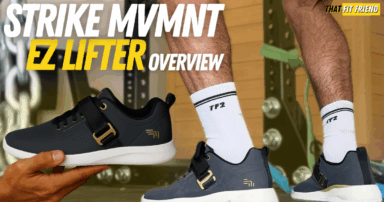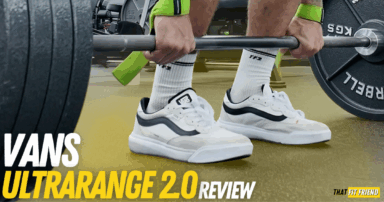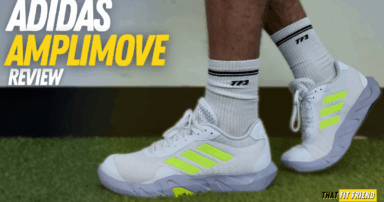The Reebok Nanoflex TR, Reebok Nano X1, and Reebok Nano X all deliver performances in the gym. Each of these models comes with its own list of pros and cons, and unlike iterations like the Reebok Nano X and Reebok Nano 9, all three of these models discussed in this cross-training shoe comparison are very different.
If you’re in the market for new Reebok Nanos, you’re in luck. Every year, we see multiple Reebok Nano iterations released, which is awesome for giving us a variety of shoes to choose from.
However, that tends to add confusion around which pair of Nanos you should go with. You’ve likely wanted to know the differences between the Reebok Nanoflex TR vs Reebok Nano X1 vs Reebok Nano X.
Personally, I love each model in the gym for slightly different reasons. I wanted to put this Reebok Nano comparison article together to help you decide which model fits your training needs and wants best.
Reebok Nanoflex TR Vs Nano X1 Vs Nano X Performance
To break down each shoe’s performance, I’m going to compare each model in the context of lifting and CrossFit, versatile training, and running, then select a winner and discuss my thoughts as to why.
Stability With Lifting and CrossFit
When it comes to stability and CrossFit performance, all three of these shoes are very different. The Reebok Nano X is by far the best model of these three for lifting heavy and tackling CrossFit workouts. This model features a 4mm heel-to-toe drop and a high-density midsole construction that can accommodate loads of over 500 lbs.
In the Reebok Nano X, I’ve trap bar deadlifted 525 lbs for reps to test its stability and didn’t notice any major issues with compression. Additionally, this model also features a durable upper and construction and mid-foot support for tackling exercises that you’ll commonly see in CrossFit workouts like rope climbs and burpees.
Of these three, the Reebok Nano X is by far the most superior model for CrossFit, especially when you consider its durability.
The Reebok Nano X1 has a 7mm heel-to-toe drop and works decently well for moderate loading and casual CrossFit workouts. This model has a Floatride Energy Foam midsole that has a decent level of responsiveness while also being fairly adequate for limiting a ton of compression.
For stability testing, I’ve lifted over 500 lbs in this model, too, and it worked well, but there is definitely a lower threshold for compression compared to the Reebok Nano X.
The upper in the traditional Reebok Nano X1 is also not the most durable for abrasion resistance in CrossFit workouts and I’d suggest looking into the Nano X1 Adventure or Grit for increased durability.
The Reebok Nanoflex TR is the lowest tier model between the three when it comes to supporting heavier lifting. This model is marketed as a budget-friendly Reebok Nano and it’s pretty clear to see that its construction doesn’t hold up to the same intensity of tasks as the Nano X and Nano X1.
The Nanoflex TR has a 4mm heel-to-toe drop and a foam midsole that does an okay job under heavier loads up to 455 lbs. For many, this shoe could technically work for their training and lifting. Still, the upper of this model also doesn’t provide the same level of durability for CrossFit workouts as the Reebok Nano X and some of the Nano X1 iterations.
Winner: Reebok Nano X
HIIT, Agility, and Plyometrics
Based on the lifting performance of each shoe, you could probably already guess which models excel for more versatile style training. Generally, when a shoe is more stable, then we’ll start to see versatility and responsiveness go down a bit. Of these three models, the Reebok Nano X1 takes the edge for HIIT, agility, and plyometric work.
I like the lug patterning on the outsole of this model, as it provides adequate traction on various surfaces. In addition, the Floatride Energy Foam midsole provides a nice bounce with this model and makes it a solid model, not beating up the feet with longer sessions that include a bunch of jumping.
Below, I’ve included a shot of my Nano X1 Adventure to highlight its midsole construction, this is model my favorite Nano X1 iteration due to its outdoor capabilities.
The Reebok Nanoflex TR works decently for versatile training, and its midsole can accommodate this style of training fairly well. However, the drawback and downfall of the Nanoflex TR are its forefoot and boot construction. At times, this model can get a little uncomfortable in the forefoot and boot which can quickly make this model a turnoff for this style of training.
That being said, if you’re training more casually in a versatile context and need a budget-friendly model, then I think the Reebok Nanoflex TR is a good option. It will get the job done for most who wear them for hour-long sessions here and there or in classes.
The Reebok Nano X works for this training style, but it’s not my first choice due to its overall stability. This model will excel in CrossFit workouts, but if you’re tackling a HIIT session, class, or even more athletic-focused training, you may find them to be a bit too stable at times.
The split outsole is flexible and the high-density forefoot midsole help to mitigate this model’s overall stability, however, it’s still not going to be a responsive as something like the Reebok Nano X1 and Reebok Nanoflex TR.
Winner: Reebok Nano X1, followed by the Reebok Nanoflex TR for more casual training.
Shorter Runs
When it comes to shorter runs, it’s clear when comparing the Reebok Nano X1, Reebok Nano X, and Reebok Nanoflex TR. If you want to tackle runs that are around 1-5 miles in length, then the Reebok Nano X1 will be your best bet. This model can tackle shorter, and mid-range runs with relative ease.
Also, if you like to train outside, then I’d suggest looking into the Reebok Nano X1 Adventure. This model features slightly thicker lugs on the outsole, and it’s a fairly good model for tackling easy and semi-technical terrain when trail running.
The Reebok Nanoflex TR can work for runs, but I’d suggest capping your mileage to 1-2 miles as this model can get uncomfortable at times, as mentioned above. Plus, the midsole while being more responsive than the Reebok Nano X isn’t my favorite for running.
As you’ve likely already guessed, the Reebok Nano X with its stable construction isn’t the best for tackling runs. It will work for shorter runs, but I’d suggest capping your running in the Reebok Nano X to around 800 meters or less. That said, if you have a CrossFit workout with shorter runs programmed, then the Nano X should get the job done just fine.
Winner: Reebok Nano X1 (go with the Adventure if you run outside!)
Reebok Nanoflex TR Vs Nano X1 Vs Nano X Construction
To make the following section easier to read through, I’ve broken down this construction section into multiple parts.
Outsole
All three of these models feature full rubber outsoles. However, their treads are all very different. The Reebok Nano X1 features a consistent lug patterning. These lugs provide adequate traction on indoor and outdoor surfaces. The Reebok Nanoflex TR features a flex-groove tread pattern with some exposed midsole layers throughout the forefoot.
The Nanoflex TR grips gym floors really well, and as a whole, I haven’t noticed any durability issues with this model’s outsole construction. On the Reebok Nano X, we have the signature split outsole construction to promote forefoot and heel separation and the meta-split feature throughout the forefoot.
There really isn’t an outsole construction of these three that is an under-performer. They’re all very different and excel in different contexts for slightly different reasons. In a training context, the outsoles on these models all perform consistently well.
Midsole
The midsole constructions of these models are all fairly different, which is neither good nor bad; they’re just different. The Reebok Nanoflex TR has a consistent foam midsole throughout that offers a fairly consistent blend of responsiveness and stability. To be honest, the midsole in this model is one of the main reasons I’m reminded as to why this is the budget-friendly Reebok Nano.
The Reebok Nano X features a high-density foam midsole that you can see throughout the forefoot and has a TPU overlay covering the midsole of the midfoot and heel.
As a whole, the midsole in this model doesn’t compress a ton, and it airs a bit more stable in its construction.
As mentioned earlier in this article, the Reebok Nano X1 features Reebok’s signature Floatride Energy Foam throughout. This midsole construction has grown on me, and I wasn’t actually the biggest fan of it in my first impressions, but after 6-months of training in them, I like the Floatride Energy Foam midsole.
Upper Construction
In these three models, the upper constructions are all fairly different. My favorite of the three is the Reebok Nano X’s upper construction. This model features Reebok’s signature Flexweave and there are multiple areas on the shoe with additional overlays of material for added durability. For example, the midfoot and heel both have additional layers for durability purposes.
The Reebok Nano X1 and Nanoflex TR have fully mesh uppers. The Nano X1’s mesh breathes a bit better and has a bit more stretch to it, which gives it a slightly more maneuverable fit and feel compared to the Nanoflex TR’s upper. The Reebok Nanoflex TR’s mesh has a bit more of a gritty feel to it and doesn’t stretch nearly as well as the Nano X1.
Laces and Tongue
Both the Reebok Nano X1 and Reebok Nanoflex TR feature six-core eyelets with a seventh eyelet for lace-lock. The Nano X1’s lacing system is fairly durable and features thicker synthetic overlays as eyelets, while the Nanoflex TR has a blend of mesh eyelets and synthetic eyelets.
The Reebok Nano X1 features five eyelets, and there’s a lot more material surrounding them compared to the Nano X1 and Nanoflex TR. Personally, I like this for durability purposes, especially for prolonging lace life when performing things like rope climbs.
Insole
Of these three models, two of them feature removable insoles. These two models include the Reebok Nano X1 and Reebok Nano X, both of which feature a thinner removable insole. If you have custom orthotics, you should be fine using them in these models, and they have slightly deeper midfoot and boot construction compared to other low-profile cross-training shoes.
The Reebok Nanoflex TR does not feature a removable insole. On top of this, it’s not even an insole that only has a little adhesive keeping it in place. The insole in this model is firmly built-in and I’d suggest not removing it to prevent any early breakdown in this model. For this reason, I don’t think the Nanoflex TR is good for anyone with custom insoles and orthotics.
Reebok Nanoflex TR Vs Nano X1 Vs Nano X Durability
Over the last six-plus months, I’ve trained hard in all of these models and have a fairly good idea regarding each model’s durability. Of these three shoes, there is a clear winner with durability, and that’s the Reebok Nano X, which is likely not a surprise based on the rest of the context of this comparison.
The Reebok Nano X’s Flexweave upper is excellent for abrasion resistance, and the midsole and outsole both hold up reasonably well to serious training. For the regular Reebok Nano X1, the durability is okay, but I’d say go with the Nano X1 Grit or Adventure if upper durability is your concern.
The Reebok Nanoflex TR’s upper is okay, but when compared to the other two models, it’s pretty easy to feel and see that it’s the budget-conscious Reebok Nano. This model’s upper should last you a while if you’re training in them recreationally and casually, but it’s definitely not the best for abrasion resistance or serious training.
Reebok Nanoflex TR Vs Nano X1 Vs Nano X Sizing
For the Reebok Nanoflex TR, Reebok Nano X, and Reebok Nano X1, most lifters and athletes should be safe going true-to-size. However, each model fits slightly differently, and I’ll share more of my thoughts on them below.
- Reebok Nano X1: True-to-size, but the boot can cause friction for some despite them fitting well in regard to length and width. I’d suggest wearing longer socks when breaking these in.
- Reebok Nanoflex TR: True-to-size, but the forefoot and boot construction can be a bit uncomfortable for some. Of these three models, the Nanoflex TR fits the most narrow especially through the midfoot and forefoot transition.
- Reebok Nano X: True-to-size. Generally, this model fits the best, but a small population of lifters may experience heel slip in this model and since there are only five eyelets you can be limited with navigating that issue with this model.
If you have any additional questions about sizing, please don’t hesitate to drop a comment below or reach out to me and I can try to help accordingly.
Price Comparison
The good thing about all three of these models is that their price points vary pretty drastically. For example, all of these models regularly go on sale for different promotions and in different colorways, so more than likely, you can find a good deal on the pair you’re after.
Generally, the Reebok Nano X1 will cost $130 USD, while the Reebok Nano X will cost $130 USD or be on sale due to it being an older model. In my opinion, if you can find a pair of Nano Xs for less than $100 USD, then that’s a really good deal. The Reebok Nanoflex TR has a price point around $90 but also regularly goes on sale for much less.
Takeaway Thoughts
Overall, I enjoy training in the Reebok Nano X1, the Reebok Nano X, and the Reebok Nanoflex TR for different reasons. Each model excels for different reasons, and I think everyone can likely find a model between these three that fits their training needs and preferences really well.
If you have any questions about these models, drop a comment below or reach out to me personally via Instagram (@jake_boly).























Add a Comment